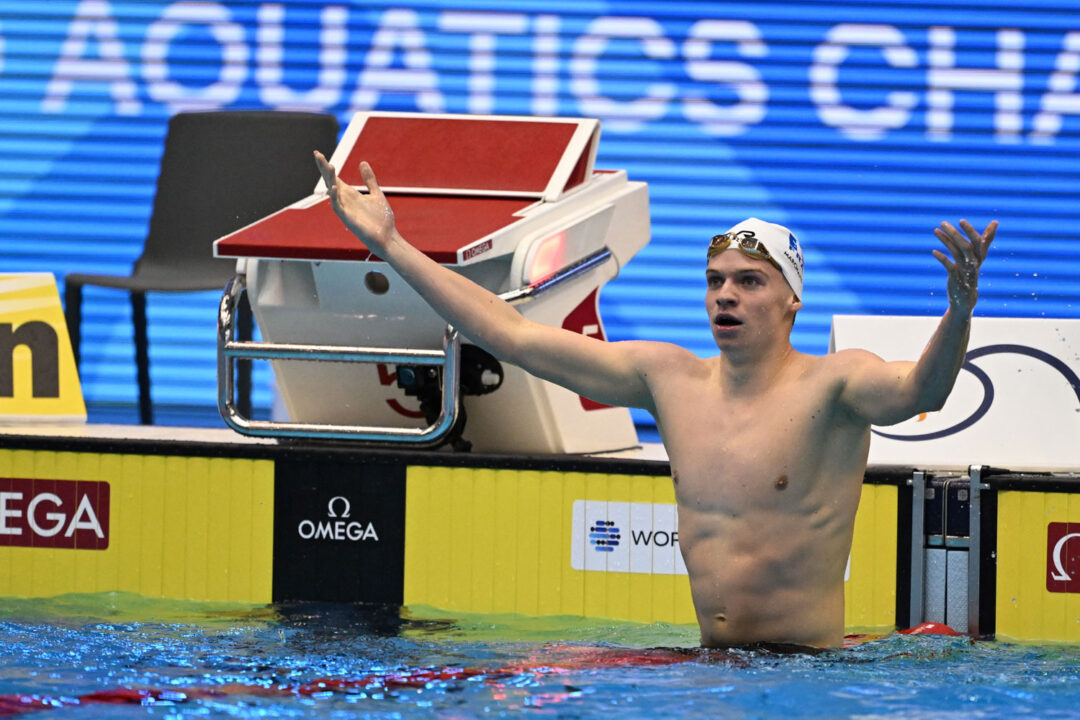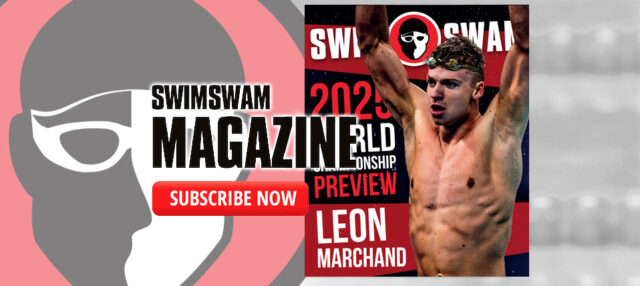Are the qualifying time standards for the 2024 Paris Olympics fair across each event? As we near the end of the qualifying period, it’s become increasingly obvious that some of the cuts are much more difficult to hit than others.
World Aquatics has determined that the Olympic Qualifying Times (OQTs) correspond to the time achieved by the 14-place swimmer in the prelims at the Tokyo Olympic Games in 2021.
In eight events, the 14th-place swimmer in Tokyo was actually slower than the established OQT at the time, so in those races, the qualifying time for Tokyo remains intact (established from the 14th-place time at Rio 2016). Those events are the women’s 400 free, 200 back, 100 fly, 200 fly, and 400 IM, and the men’s 400 free, 1500 free and 200 back.
Theoretically, this would make all the OQTs the same level of difficulty. But that’s not quite what happens.
And this is something that could be predicted. After all, in the same Olympics, different events may have varying levels of competition.
To illustrate this, Instagram’s Swimming Stats page has brought the number of swimmers who have achieved times below the OQTs, per event, so far, in the meets approved by World Aquatics, in the period between March 1, 2023, and June 23, 2024.
View this post on Instagram
A maximum of two swimmers per country in each event have been considered, in accordance with the rules established by World Aquatics.
There are some alarming numbers, and there is a huge discrepancy between certain events.
For example, let’s compare the same event, 800 free, for men and women. So far, there are a potential 33 swimmers in the men’s race for Paris, compared to just 12 in the women’s race.
In fact, in addition to the women’s 800 free, the men’s 400 IM also features just 12 qualifies. On the other hand, the event with the most swimmers is the men’s 50 free, with 36 — three times as many.
And despite there being 12 swimmers with times faster than the OQT of 4:12.50 in the men’s 400 IM, that doesn’t mean we’ll see all dozen of them racing in Paris.
The Japanese Federation established faster qualifying times for Paris than World Aquatics, which resulted in Daiya Seto not earning entry into the event at the Olympics despite going under the OQT. Based on the results of the Chinese National Championships, Zhang Zhanshuo will also not be swimming the event in Paris, despite having performed faster than the OQT at the 2023 World Junior Championships.
As World Aquatics has said that swimmers who have obtained the ‘B’ cut (OCT – Olympic Consideration Times) during the 2024 Paris Olympic qualifying period may not make the cut due to the athlete quota, then, at the moment, the likely start list for the race would have only 10 swimmers:
- Leon Marchand (FRA)
- Carson Foster (USA)
- Chase Kalisz (USA)
- Max Litchfield (GBR)
- Alberto Razetti (ITA)
- Lewis Clareburt (NZL)
- Tomoyuki Matsushita (JPN)
- Brendon Smith (AUS)
- Tristan Jankovics (CAN)
- Cedric Bussing (GER)
There are still some trials to take place (France, Australia, United States) and athletes can obtain the time standards until June 23, 2024. But the fact that very few swimmers have hit them since March 2023 in the men’s 400 IM is worrying. It is unlikely that we will see more than 16 swimmers in the race, which will only give us two preliminary heats.
By way of comparison, the OQT of 4:12.50 in the men’s 400 IM would worth a bronze medal at the 2024 World Championships. The OQT of 7:51.65 in the men’s 800 freestyle would only be worth the 18th position at the same World Championships. The 2024 Worlds was unique and didn’t have the same level of competitiveness that we would see at a normal World Championships, but still, the disparity is jarring.
This illustrates the fact that OQTs have different levels of difficulty. For some reason, the preliminary heat times for the men’s 400 IM (and some other events) were very fast in Tokyo 2021 – so much so that, in a bizarre way, the time of the 8th place qualifier (4:10.20, by Max Litchfield from Great Britain) would have won the bronze medal in the final (which was won by Brendon Smith from Australia in 4:10.38).
That kind of thing can happen, and in this case, nearly all of the swimmers had to go full gas in the heats to try and get a lane in the final.
Given the evidence, perhaps it is not appropriate to use a single meet to determine time standards. After all, we already saw this happen in Tokyo, when, in the women’s 200 fly, we had the bizarre situation of only 16 swimmers racing—every entrant got an automatic spot in the semis as long as they didn’t DQ.
There are better ways to project time standards so that the number of swimmers below a given time standard is quite even in different events. But for this, more refined methods are needed, perhaps even involving mathematical and statistical models.
They would not be simple to explain as “the 14th time in the preliminary heats in the last Olympics”. But they would certainly be more efficient. And we would not observe such a discrepancy in the OQTs.


It would be informative to see a similar analysis of the Cutoff Times for the US Olympic Trials, since there are over 90 qualifying entrants in some events. Surely many of them are nowhere near the Olympic Qualifying Time!
We must also consider the resources it takes to train and qualify for the longer races. Access to altitude camps and facilities etc. there is a lower barrier to entry for sprinting.
I think China’s Zhang will take part in the 400 IM since they don’t have other qualifiers on the National Championships.
The time required to make the finals in the 400IM in Tokyo (4:10.20) was not only faster than the bronze medalist (4:10.38), but also the silver medalist (4:10.28)!
But remember, due to broadcasting rights, they flipped the schedule in Tokyo, meaning that finals were in the morning and prelims were in the evening.
It could be just that their bodies didn’t move as well in the morning as they did the night before.
Im thinking 400IM OQT is harder to hit not tapered than say 50 free OQT. Maybe longer events should have softer OQT so swimmers dont have to go all in in season to hit the mark
This seems like a case of “some events are just more attractive than others”
These numbers are very low.
Ridiculous of Australia and GB and Japan to make harder standards than the WA times with numbers like this. I know they don’t want tourists but the experience would be invaluable.
Also, if you are ranked top 10 in the world, I think you should get an invite anyway. Ignore the 2 per country.
Btw, I’m pretty sure Will Petric reached the 400 IM qualifying time at the Sydney Open recently. He’s not in the list. He still has to do it at trials but he’s looking good.
He is not in the list because the Sydney Open is not one of the qualifying competitions for the Olympics approved by World Aquatics.
Ahhh thanks Daniel. I see.
What would these numbers look like if it included all the swimmers from banned countries?